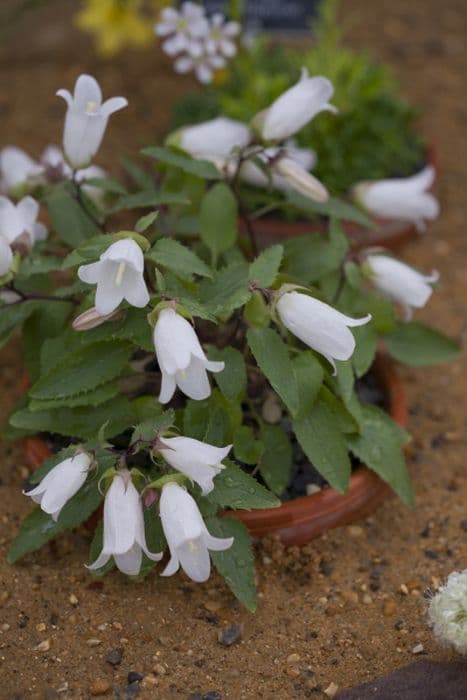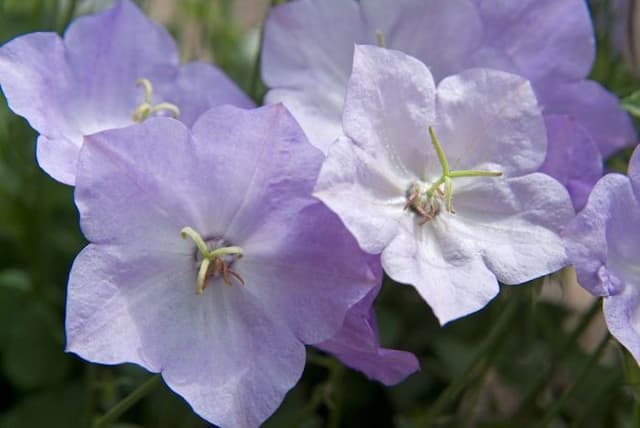Georgian Bellflower Campanula makaschvilii

ABOUT
The plant commonly known as the bellflower features a striking appearance characterized by its vibrant, bell-shaped flowers. These blooms can present in a range of colors, commonly seen in hues of blue, violet, or sometimes white. The petals are fused at the base, forming a tubular cup that flares open at the mouth into five lobes, giving the look of a classic bell. This plant owns a delicate allure, with flowers gracefully poised atop slender stems. The foliage of the bellflower is typically lush and green, with leaves that can be either broad and heart-shaped or more narrow and lance-like, depending on the variety. These leaves often have a slightly serrated edge, adding texture to the soft clumps of foliage from which the flowering stalks rise. The visual appeal of the bellflower is enhanced by the contrast between the striking flowers and the verdant leaves, making it a favorite in gardens where it is used for borders, rockeries, or as a charming ground cover.
About this plant
 Names
NamesFamily
Campanulaceae
Synonyms
Georgian Bellflower
Common names
Campanula makaschvilii.
 Toxicity
ToxicityTo humans
Campanula makaschvilii, commonly known as Bellflower, is not widely recognized as a toxic plant to humans. There is no significant evidence to suggest that this plant is poisonous, and it does not typically pose a threat when touched or ingested in small quantities. However, as with any plant, individual allergies or sensitivities can occur, and it's always advisable to avoid eating any plant material unless it's known to be safe and edible.
To pets
Bellflower, or Campanula makaschvilii, is also not specifically known to be toxic to pets. Most members of the Campanula family are considered to be non-toxic to animals, so it is unlikely that pets would experience any significant symptoms of poisoning from ingesting this plant. However, ingestion of any plant can potentially cause mild gastrointestinal upset in some pets due to the fiber content or individual sensitivities, so it's best to prevent pets from consuming plants not intended for consumption.
 Characteristics
CharacteristicsLife cycle
Perennials
Foliage type
Deciduous
Color of leaves
Green
Flower color
Blue
Height
1-2 feet (30-60 cm)
Spread
1-2 feet (30-60 cm)
Plant type
Herb
Hardiness zones
5
Native area
Caucasus
Benefits
 General Benefits
General Benefits- Attractive Aesthetic: Adds beauty to gardens with its blue or violet bell-shaped flowers.
- Pollinator Support: Appeals to bees, butterflies, and other beneficial insects that are vital for pollination.
- Low Maintenance: Requires minimal care once established, making it suitable for novice gardeners.
- Drought Tolerance: Has the ability to withstand dry conditions after it is established, reducing the need for frequent watering.
- Ground Cover: Ideal for covering bare spots, controlling weeds, and preventing soil erosion.
- Seasonal Interest: Provides a burst of color in the garden during its blooming season which is typically from late spring to early fall.
- Rock Gardens: Well-suited for rock gardens or alpine gardens due to their compact and hardy nature.
- Container Gardening: Can be grown in pots or containers, making it versatile for balconies and patios.
 Medical Properties
Medical PropertiesThis plant is not used for medical purposes.
 Air-purifying Qualities
Air-purifying QualitiesThis plant is not specifically known for air purifying qualities.
 Other Uses
Other Uses- Decorative ice cubes: The bellflower's petals can be frozen in ice cubes to add a floral touch to beverages.
- Edible garnish: The petals of the bellflower can adorn salads or desserts, providing a splash of color and mild flavor.
- Book pressing: The flowers can be pressed and dried to be used as decorative bookmarks or in crafting.
- Photography subject: With its unique shape, the bellflower makes an attractive subject for botanical photography.
- Fairy gardens: Due to their delicate appearance, bellflowers are a popular choice for creating enchanting fairy garden displays.
- Plant dye: The pigments of the bellflower can be used in creating natural dyes for fabrics or art projects.
- Wedding bouquets: The soft look of the bellflower makes it suitable for inclusion in wedding floral arrangements.
- Potpourri ingredient: Dried bellflower blooms can contribute to the fragrance and visual appeal of homemade potpourri.
- Culinary syrup infusion: The flowers can be steeped in syrups for flavoring cocktails, teas, or desserts.
- Candle decoration: Bellflower petals can be embedded into the wax of homemade candles for a floral touch.
Interesting Facts
 Feng Shui
Feng ShuiThe Campanula is not used in Feng Shui practice.
 Zodiac Sign Compitability
Zodiac Sign CompitabilityThe Campanula is not used in astrology practice.
 Plant Symbolism
Plant Symbolism- Persistence: The Campanula, commonly known as Bellflower, often symbolizes persistence due to its ability to grow in difficult conditions and its steadfast blooms.
- Gratitude: Bellflower can also represent gratitude, as it is a plant that can thrive with minimal care, reflecting the appreciation for simple, steadfast relationships.
- Constancy: The long-lasting nature of Bellflower's blooms is frequently seen as a symbol of constancy and unwavering faith.
- Hope: With its upward-growing flowers, the Bellflower has come to be associated with hope and looking towards the future.
- Humility: The bell-shaped flowers, bowing down as they bloom, have been connected with humility, gently reminding the beholder to stay humble.
 Water
WaterThe Georgian Bellflower should be watered deeply but infrequently, allowing the soil to dry out slightly between waterings. Generally, the plant requires watering once a week, with approximately one to two gallons of water, depending on the size of the plant and the environmental conditions. It's important to ensure that the plant is not left in standing water as this could lead to root rot.
 Light
LightThe Georgian Bellflower thrives in partial shade to full sun. It prefers bright, indirect sunlight and should be protected from the harsh afternoon sun. A spot that provides morning sunlight with dappled shade in the afternoon is ideal for this plant.
 Temperature
TemperatureThe Georgian Bellflower prefers moderate temperatures and can survive in conditions that range from around 30°F to 85°F. However, it thrives at a temperature between 60°F and 75°F. Extreme temperatures below 30°F can damage the plant.
 Pruning
PruningThe Georgian Bellflower benefits from pruning to remove dead or faded flowers and encourage further blooming. This plant should be pruned after its main flowering period, which usually is in the summer, to maintain its shape and promote healthy growth.
 Cleaning
CleaningAs needed
 Soil
SoilGeorgian bellflower thrives in well-draining soil with a pH range of 6.0 to 7.5. A soil mix of equal parts potting soil, peat, and perlite or sand facilitates good drainage and aeration.
 Repotting
RepottingGeorgian bellflowers do not require frequent repotting; repot them every 2-3 years or when they outgrow their current container.
 Humidity & Misting
Humidity & MistingGeorgian bellflowers prefer moderate humidity levels but are quite adaptable, making them suitable for typical indoor humidity conditions.
 Suitable locations
Suitable locationsIndoor
Keep in bright, indirect light and water moderately for Georgian bellflower.
Outdoor
Plant in partial shade to full sun with moist, well-drained soil for Georgian bellflower.
Hardiness zone
5-9 USDA
 Life cycle
Life cycleCampanula makaschvilii, commonly known as the bellflower, initiates its life cycle as seeds, which are dispersed and find suitable soil in which to germinate. Upon germination, seedlings emerge and grow into vegetative plants, developing a rosette of basal leaves. The plant then enters a period of vegetative growth, maturing and increasing in size. During the flowering stage, it produces tall flowering stalks with bell-shaped flowers which are typically blue or violet, although they may vary in color. After pollination, which is often facilitated by insects, the flowers produce fruit in the form of capsules containing numerous small seeds. The plant completes its life cycle when these seeds are released to begin a new generation, and the parent plant eventually dies after setting seed, which could occur after a single season (annual) or several years (perennial), depending on growing conditions and the specific traits of the bellflower.
 Propogation
PropogationPropogation time
Spring-early summer
The most popular method of propagating Campanula makaschvilii, commonly known as the Caucasian Bellflower, is through seed sowing. The optimal time to sow seeds is in spring after the last frost when the soil has begun to warm up. Seeds should be scattered lightly on the surface of a well-drained seed starting mix and gently pressed into the soil, as they require light for germination. The soil should be kept moist but not waterlogged. Germination typically occurs within two to three weeks. Once seedlings have developed their first true set of leaves and are large enough to handle, they can be transplanted to their final locations, ensuring a spacing of about 12 inches (approximately 30 centimeters) to accommodate their mature spread.









![Milky bellflower [Avalanche]](/_next/image?url=https%3A%2F%2Fplants-admin.emdemapps.com%2Fimages%2Fplants%2F%2Fimages%2F604b5dc88c1e7.png&w=640&q=75)